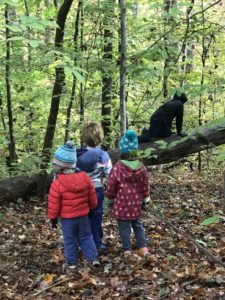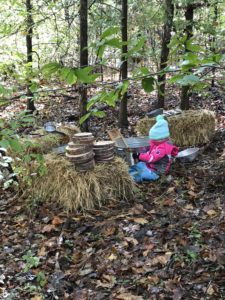 “Between every two pines is a doorway to a new world.” John Muir
“Between every two pines is a doorway to a new world.” John Muir
The weather may have been colder, but that didn’t dampen the fun at the second session of the Muddy Boots Play Group, our model forest kindergarten at Bernheim, held on Saturday, Oct. 28. Despite the coldest temperatures of the fall season so far, our forest friends spent nearly 3 hours outside climbing trees, using tools, exploring the forest, learning about fire, making friends, and building resiliency.
As children arrived that cold crisp morning, many ran straight for the new tools we placed around the cabin at the Woodland Pavilion – the rakes and shovels and wheelbarrows – and for the mud puddles leftover from rain the night before.
Soon we gathered inside the cabin for circle time, an opportunity for sharing and setting a rhythm for the day.
Good Morning Dear Earth
Good Morning Dear Sun
Good Morning Dear Flowers
And the Fairies, Every One
Good Morning Dear Beasts
And The Birds in the Tree
Good Morning to You and Good Morning to Me
We then headed across the street and into the forest for free play. There was excitement when the children noticed a mouse scurrying across the forest floor. One friend decided if there was one mouse, there must be more. He began turning over hay bales and before the day was through, he had engineered a trap using a bucket and a rope in case it returned.
Ropes and tarps and string and shovels are all waiting in the forest, as is a circle of stumps and a small tarp shelter, a sand box in a half barrel and what we call our mud kitchen, pots and pans, cups and wooden spoons that the children use to make “stews” and other concoctions with the natural materials they find in the forest.
While all of those are inviting, the most popular spots in the forest are the felled trees, perfect for climbing and crawling, and the dirt piles that are open-ended invitations for whatever the children might want to explore. They may crawl across the fallen tree, discovering how as they watch their friends and learn how to balance themselves. Then, of course, they have to figure out how to get down, which is sometimes a challenge to figure out and a test of their own physical abilities and courage.
This day, unlike the first, we observed the children involved in deep, rich play. They engaged for longer periods of time following their own interests constructing and testing and investigating. They had become more comfortable in their forest “home.” They remembered some of their friends from the time before. Returning to the same site with the same friends is an important feature of forest kindergarten. The intent is for the children to develop a connection to a particular, natural place they make their own. Although we started this program by offering individual, stand-alone sessions, Muddy Boots has quickly, and naturally, developed a common cohort of children. For our second session, 9 of the 12 children were repeat customers.
One friend found his first Muddy Boots woodland experience, with new friends, new teachers and an unfamiliar environment, a little overwhelming. But on his second visit to the woods, to the same site with familiar teachers and friends, he explored freely and confidently, secure enough to try climbing a tree on his own and making new friends, one who offered her hand on the walk back to the cabin site, where we warmed our fingers and toes during lunch before “mud” painting or making creations of acorns and thistles, or whatever activity the children could imagine before our forest time came to an end.
Because Muddy Boots is intended as a forest kindergarten model, we have created it using as many of the central tenets of forest schools as we can:
- We spend nearly all of our time outdoors – no matter the weather.
- We do not have a set curriculum. The children play freely, learning as they go through inquiry and exploration.
- We keep the enrollment low in order to maintain a teacher-to-child ratio of 1 to 4. This helps create an intimate setting for child-led learning.
- We’ve identified a forest and cabin site that provides children with a safe base from which to explore.
- We offer a variety of loose parts, materials that can be moved, carried, combined, redesigned, lined up, and taken apart and put back together in multiple ways. Nature itself is a storehouse of loose parts that truly requires no additions. But all of these are loose parts, which do not come with a set of specific directions. The child is the direction.
- We introduce tools that give children opportunities for mastery and new skills.
- We let children navigate risk, as they are able, while protecting them from hazards.
But most of all, we hold as sacred the space that children need to play, freely, in order to become the healthy, whole adults they are meant to be.







